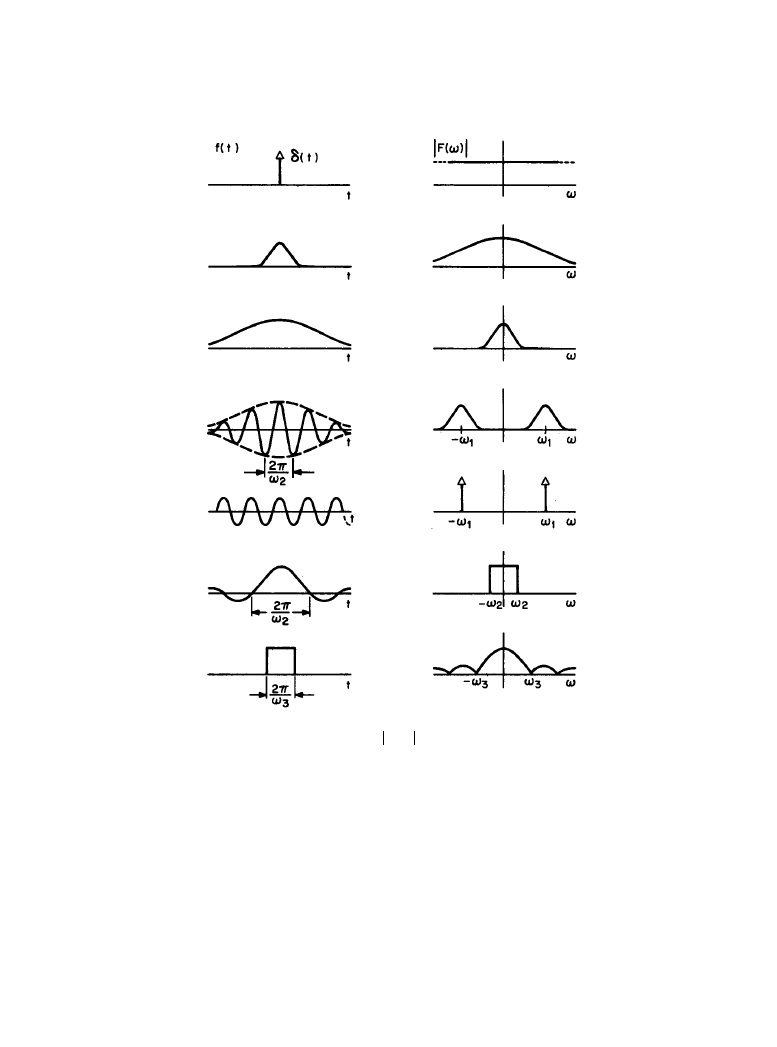ВУЗ: Казахская Национальная Академия Искусств им. Т. Жургенова
Категория: Книга
Дисциплина: Не указана
Добавлен: 03.02.2019
Просмотров: 21593
Скачиваний: 19

Signals and Spectra 2-17
f(t) its average spectral density F(
ω) and associated phase at each frequency ω throughout a con-
tinuum of frequencies. The original signal f(t), again analogously to Fourier analysis, can be
reconstructed from its spectral density by using the relation
(2.1.22)
f t
( )
1
2
π
------
F
ω
( )e
j
ωt
d
ω
∞
–
∞
∫
=
Figure 2.1.5
Amplitude spectral density
corresponding to time-domain signals
f(t).
F
ω
( )
Downloaded from Digital Engineering Library @ McGraw-Hill (www.digitalengineeringlibrary.com)
Copyright © 2004 The McGraw-Hill Companies. All rights reserved.
Any use is subject to the Terms of Use as given at the website.
Signals and Spectra

2-18 The Audio Spectrum
where all frequencies, instead of discrete frequencies, are used. Equations (2.1.21) and (2.1.22)
form a Fourier-transform pair. By comparing these two equations it is seen that the value of f(t)
at, for example, t = t
1
depends on contributions from F(
ω) at all frequencies and, conversely, that
the value of the spectral density F(
ω) at ω = ω
1
depends on contributions from f(t) at all times. In
both cases integrals with infinite limits are evaluated. In Figure 2.1.5, several Fourier-transform
pairs are illustrated.
The relations (2.1.21) and (2.1.22) can be derived from the Fourier-analysis Equations
(2.1.12) and (2.1.15b) by using a limiting process where the period T becomes infinite and the
frequency interval between harmonics approaches zero.
The continuous Fourier transform (Equation 2.21) is often approximated or estimated by
using the discrete Fourier transform (2.1.18) by assuming that f(t) is periodic, with period T, and
that its high-frequency content is zero beyond harmonic number N/2, where N equals the number
of equally spaced sampled values of f(t) within the assumed period.
The Laplace transformation F(s) uses the complex variable
in place of j
ω in
Equation (2.1.21) with the lower limit of integration set equal to zero. The quantity
is a
convergence factor that exponentially damps out f(t) as
. This transform is used in applica-
tions where finite-power signals (like sinusoids) that are zero for negative values of time are
needed. While the inversion of the Laplace transform is more complicated than Equation
(2.1.22), tables of transform pairs are available for commonly used signals.
2.1.2f
Impulse Signal
The unit impulse is a very important finite-energy signal that is denoted by
and defined by
the constant spectral density F(
ω) = 1 and zero phase for all frequencies. Substituting F(ω) = 1 in
Equation (2.1.22) gives
(2.1.23)
Because
+
and the odd function sin (
ωt) integrates to zero, Equation
(2.1.23) can be interpreted as summing (integrating) unit-amplitude cosine waves of every fre-
quency. When t = 0, cos (
ωt) = 1 regardless of the frequency ω, so that all the cosine waves rein-
force one another, giving
infinite value. At times other than t = 0, the cosine waves
destructively interfere and cancel, so that
for
. Consider, for example, the last
example given in Figure 2.1.4 as the number of harmonics and length of the period are increased
without limit. By using Equation (2.1.21) with
and the fact that F(
ω) = 1
(2.1.24)
which implies that the value of the integral is simply the value of the integrand, in this case
evaluated or sampled at t = 0. If the numerical value 1 is substituted for
in Equation
(2.1.24), then the integral of
itself results, which also equals 1. By interpreting this latter
integral as the area underneath
, the entire contribution to the value of the integral must
come when t = 0 because
is zero at other times. The unit impulse
, also called a delta
s
σ jω
+
=
σ 0
>
t
∞
→
δ t
( )
δ t
( )
1
2
π
------
e
j
ωt
d
ω
∞
–
∞
∫
=
e
j
ωt
ωt
( )
cos
=
j
ωt
( )
sin
δ t
( )
δ t
( )
0
=
t
0
≠
f t
( )
δ t
( )
=
1
δ t
( )e
j
ωt
–
dt
∞
–
∞
∫
=
e
j
ωt
–
e
j
ωt
–
δ t
( )
δ t
( )
δ t
( )
δ t
( )
Downloaded from Digital Engineering Library @ McGraw-Hill (www.digitalengineeringlibrary.com)
Copyright © 2004 The McGraw-Hill Companies. All rights reserved.
Any use is subject to the Terms of Use as given at the website.
Signals and Spectra

Signals and Spectra 2-19
function, belongs to a class of singularity functions. It has many different interpretations in terms
of limits of sequences of functions, one of which is the limit of a rectangularly shaped pulse
whose width shrinks to zero and whose height increases to maintain constant area under the
pulse so that the integrated value always is unity. The dimensions of
are 1/time or fre-
quency.
The delta function provides an interesting link between line spectra and spectral density
because finite-power signals can be interpreted as delta functions (in frequency) in the spectral
density. For example, the finite-power signal
has spectral density
(2.1.25)
This can be verified by inserting Equation (2.1.25) into Equation (2.1.22) and evaluating the
integral by using the sampling property of the delta function. The result is
(2.1.26)
From this example, it is clear that spectral density is a more general concept than line spectra.
2.1.2g
Power Spectrum
In Fourier analysis, the product
is integrated with respect to time to resolve or extract
the frequency components, either discrete as in Equation (2.1.12) or continuous as in Equation
(2.1.21), from f(t). These frequency components also manifest themselves as a function of in
the product
, where is a time-shift parameter. For example, if
,
this latter product is
(2.1.27)
For a fixed value of the parameter , the first term on the right of Equation (2.1.27) oscillates in
time t at 2
ω
1
and has constant phase angle
(it is a sinusoid), while the second term does not
depend on time t (it is a constant). By defining
as the time average of the product
(2.1.28)
and inserting Equation (2.1.27) into Equation (2.1.28), the sinusoid at 2
ω
1
with fixed phase inte-
grates to zero for every choice of , and the second term contributes to yield
(2.1.29)
δ t
( )
A
ω
1
t
(
)
cos
F
ω
( )
2
π
A
2
---
δ ω ω
1
–
(
)
A
2
---
δ ω ω
1
+
(
)
+
=
f t
( )
A
2
--- e
j
ω
1
t
e
j
ω
1
t
–
+
(
)
A
ω
1
t
(
)
cos
=
=
f t
( )e
j
ωt
–
τ
f t
( )f t τ
+
(
)
τ
f t
( )
A
ω
1
t
(
)
cos
=
A
2
ω
1
t
(
)
cos
ω
1
t
ω
1
τ
+
(
)
cos
A
2
2
------
2
ω
1
t
ω
1
τ
+
(
)
cos
A
2
2
------
ω
1
τ
(
)
cos
+
=
τ
ω
1
τ
r
τ
( )
r
τ
( )
lim
T
∞
→
1
T
---
f t
( )f t τ
+
(
)dt
T/2
–
T/2
∫
=
τ
r
τ
( )
A
2
2
------
ω
1
t
(
)
cos
=
Downloaded from Digital Engineering Library @ McGraw-Hill (www.digitalengineeringlibrary.com)
Copyright © 2004 The McGraw-Hill Companies. All rights reserved.
Any use is subject to the Terms of Use as given at the website.
Signals and Spectra

2-20 The Audio Spectrum
The coefficient A
2
/2 equals the power of
, and the function
oscillates at
the same frequency
ω
1
but as a function of rather than t. Because f(t) generally would contain a
multitude of different frequencies, it is worthwhile to examine the spectral properties of
.
The Fourier transform of
in Equation (2.1.28), using the variable instead of t in Equation
(2.1.21), is
(2.1.30)
and defined as the power spectrum or power spectral density of the finite-power signal f(t). In
Equation (2.1.28),
is called the autocorrelation function of f(t), and its value for
is
the average power of f(t) as defined in Equation (2.1.2). The autocorrelation function also equals
the inverse Fourier transform of the power spectral density, which, from Equation (2.1.22), is
(2.1.31)
Similarly to Equations (2.1.25) and (2.1.26) for spectral density, the power spectral density asso-
ciated with Equation (2.1.29) would consist of delta functions of strength
at fre-
quencies .
Equations (2.1.28) and (2.1.30) are very useful when spectral properties of a non-determinis-
tic, finite-power signal f(t) = n(t), arising, for example, from a noise process, are studied. By def-
inition, no functional relationship exists between n(t) and t. The signal has finite average power
but does not, in general, consist of pure sinusoids at fixed frequencies with constant phase that
are representable by line spectra. Therefore, Fourier-analysis methods are not directly applicable.
Normally, the autocorrelation function
in Equation (2.1.28) is a finite-energy signal which
first can be estimated from a sufficient number of samples of f(t), then Fourier-transformed as in
Equation (2.1.30). The result is a power spectral density as a function of continuous frequency.
The autocorrelation function contains oscillations at all the frequencies contained in f(t) with
amplitudes equal to their respective powers, as illustrated by Equation (2.1.29) for a single fre-
quency
ω
1
, and the power spectral density integral defined in Equation (2.1.30) extracts, via Fou-
rier transformation, the distribution of power in frequency P(
ω) of the underlying noise process.
The power spectra density has zero phase because
is always an even function of .
White noise is a term used to characterize a noise process whose power spectral density is
constant or flat as a function of frequency. In contrast to an impulse, whose amplitude spectral
density is flat and is interpreted as a sum of cosine waves of all frequencies each with identically
zero phase, the phases of the similar cosine waves in white noise would vary randomly in time.
The former is a finite-energy signal existing for one instant in time and the latter a finite-power
signal existing for all time; both have continuous, flat spectra.
2.1.2h
Analytic Signal
The actual waveshapes of certain signals, viewed in the time domain, appear to have identifiable
amplitude-modulation (AM) and frequency-modulation (FM) effects that may vary as time
progresses. This is not easily recognized in the signal's spectrum unless the modulation and sig-
f t
( )
A
ω
1
t
(
)
cos
=
r
τ
( )
τ
r
τ
( )
r
τ
( )
τ
P
ω
( )
r
τ
( )e
j
ωt
–
∞
–
∞
∫
d
τ
=
r
τ
( )
τ
0
=
r
τ
( )
1
2
π
------
P
ω
( )e
j
ωt
ω
d
∞
–
∞
∫
=
2
π A
2
4
⁄
(
)
ω
1
±
r
τ
( )
r
τ
( )
τ
Downloaded from Digital Engineering Library @ McGraw-Hill (www.digitalengineeringlibrary.com)
Copyright © 2004 The McGraw-Hill Companies. All rights reserved.
Any use is subject to the Terms of Use as given at the website.
Signals and Spectra

Signals and Spectra 2-21
nal to be modulated are simple, such as that generated by AM or FM between two sinusoids. The
analytic signal is one procedure used to define AM or FM effects and extract quantitative infor-
mation about them from the spectrum f(t). The analytic signal f
A
(t) is a linear transformation of
the signal f(t) which also has an interesting spectral interpretation.
Consider the signal
(2.1.32)
and from it form a second signal
by leading the phase of
by 90° and leading the phase
of
by 90°, which corresponds to multiplication by j and
, respectively. The second signal
is, by using Equation (2.1.5c)
(2.1.33)
The analytic signal associated with (t) is defined as [see Eq. (2.4)],
(2.1.34)
The analytic signal is a complex function of time, and its (line) spectrum contains no negative-
frequency components. Figure 2.1.6 illustrates, with phasors, the successive operations in form-
ing the analytic signal for cos (
ωt).
The amplitude or envelope E(t) and phase
of the analytic signal are defined by
(2.1.35)
so that, in terms of f(t) and
, they are
(2.1.36a)
(2.1.36b)
and, from Equation (2.1.36b), the instantaneous frequency is defined as
(2.1.37)
1
2
--- e
j
ωt
e
j
ωt
–
+
(
)
=
f t
( )
ωt
( )
cos
=
fˆ t
( )
e
j
ωt
e
j
ωt
–
j
–
fˆ t
( )
1
2
--- je
j
ωt
je
j
ωt
–
–
(
)
=
sin
ωt
( )
–
=
e
j
ωt
=
f
A
t
( )
f t
( ) jfˆ t
( )
–
=
θ t
( )
E t
( )e
j
θ t
( )
f t
( ) jfˆ t
( )
–
=
fˆ
2
t
( )
E t
( )
f
2
t
( ) fˆ
2
t
( )
+
=
θ t
( )
arctan
fˆ t
( )/f t
( )
–
[
]
=
ω
i
t
( )
d
θ t
( )
dt
-------------
=
Downloaded from Digital Engineering Library @ McGraw-Hill (www.digitalengineeringlibrary.com)
Copyright © 2004 The McGraw-Hill Companies. All rights reserved.
Any use is subject to the Terms of Use as given at the website.
Signals and Spectra